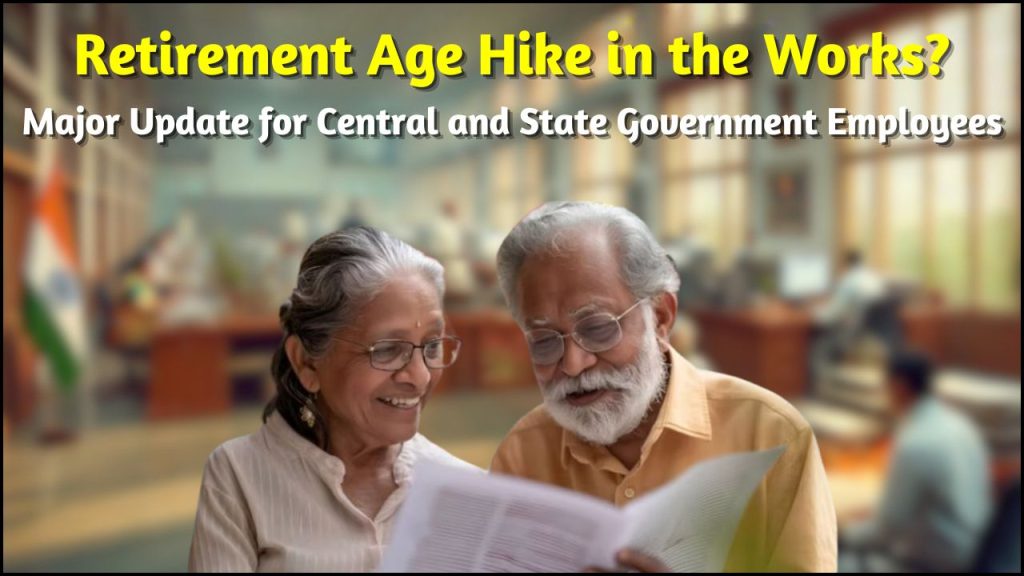
A major policy shift might be on the horizon for India’s public sector workforce. The central government is reportedly evaluating the possibility of raising the retirement age for central and state government employees. This potential change could affect lakhs of workers across the country and is being discussed in light of increasing life expectancy, workforce gaps in critical sectors, and the need to ease the financial strain on public pensions.
Why Is the Government Considering Raising the Retirement Age?
The idea of increasing the retirement age isn’t new, but recent developments have revived discussions around this subject. Several socio-economic and administrative factors have influenced the need for such a reform:
- Longer life expectancy: With healthcare advancements and improved living conditions, people are living healthier lives well into their 60s and beyond. This makes it practical to keep skilled personnel in service longer.
- Shortage of experienced professionals: Various sectors such as healthcare, education, and administration are experiencing gaps in talent. Extending the working years of seasoned employees can help alleviate this issue.
- Economic rationale: Postponing retirement can reduce the immediate burden of pension payouts, allowing for better fiscal management.
- Global influence: Countries like the U.S., Japan, and several in Europe have already increased retirement ages in response to demographic shifts. India may soon follow suit.
Current Retirement Age in India
The standard retirement age for most central and state government employees stands at 60 years. However, there are exceptions:
| Category | Current Age | Notes |
|---|---|---|
| Central Govt Employees | 60 years | Uniform across departments |
| State Govt Employees | 60–62 years | Varies by state |
| University Professors | 65 years | Higher age due to expertise |
| Judges (HC/SC) | 62–65 years | Constitutional roles |
| Armed Forces | 52–60 years | Based on rank and category |
| Medical Professionals | 62–65 years | Due to demand in the health sector |
| Scientists | 62 years | Often extended to 65 years |
Some states like Madhya Pradesh and Andhra Pradesh have already increased the retirement age to 62 for certain employees, while others are still deliberating.
What Might the New Retirement Age Be?
Although no official announcement has been made, insiders suggest that the government may push the retirement age to 62 or even 65 years, particularly in sectors with acute skill shortages. Implementation may be phased and tailored to department-specific needs.
Additionally, performance-based extensions and Voluntary Retirement Schemes (VRS) are under consideration to maintain a balance between experience retention and opportunities for new recruits.
Benefits of Increasing the Retirement Age
Raising the retirement age is expected to bring several advantages, including:
- Extended contribution from experienced professionals: Skilled and seasoned personnel can continue contributing to their departments and mentor younger employees.
- Lower pension liability: The government can delay pension disbursements, reducing short-term financial pressure.
- Workforce stability: Fewer retirements mean smoother operations and easier transition planning.
- Knowledge retention in critical sectors: Fields like healthcare, research, and education benefit greatly from institutional memory and expertise.
Here’s a look at the expected benefits:
| Benefit | Area of Impact | Description |
|---|---|---|
| Cost Savings | Govt expenditure | Delays pension payouts |
| Talent Retention | R&D, healthcare | Keeps experts on board |
| Organizational Continuity | Public service delivery | Avoids mass retirements |
| Professional Security | Employees | Ensures income for longer |
| Global Alignment | Policy benchmarking | Follows international trends |
Concerns and Challenges
Despite the apparent benefits, the idea has met with criticism and concern, particularly from younger job seekers and employee unions. Key concerns include:
- Reduced job opportunities for youth: Delayed retirements mean fewer openings for fresh candidates.
- Stagnation in promotions: Junior staff might see delays in career progression.
- Performance issues: Not all employees remain equally efficient as they age.
- Workplace friction: Generational gaps could lead to workplace conflicts.
- Health limitations: Especially for roles involving physical activity or travel, older age might not be ideal.
| Concern | Affected Group | Explanation |
|---|---|---|
| Job Scarcity | Youth | Reduced vacancies |
| Slower Promotions | Mid-level employees | Senior roles remain occupied |
| Reduced Productivity | All employees | Age-related efficiency concerns |
| Health Risks | Field workers | Older employees may struggle physically |
| Morale Issues | Office teams | Generational dynamics |
| Legal and Union Pushback | Policy makers | Risk of litigation or protests |
Retirement Age Trends in Indian States
Some states have already taken steps to raise the retirement age independently:
| State | Current Retirement Age | Status |
|---|---|---|
| Tamil Nadu | 60 years | May raise to 62 |
| Madhya Pradesh | 62 years | Implemented |
| Uttar Pradesh | 60 years | Under review |
| Andhra Pradesh | 62 years | For medical staff |
| Kerala | 60/62 years | Varies by department |
| Delhi | 60 years | Follows central norms |
These state-level decisions provide a precedent and insight into how the central government may structure its nationwide policy.
What Should Employees Do Now?
For government employees, especially those nearing retirement, it’s crucial to:
- Stay updated: Monitor official announcements or circulars for confirmation.
- Re-evaluate financial plans: Delayed retirement may impact pension planning and savings goals.
- Focus on performance: The possibility of performance-based extensions makes continued productivity essential.
- Stay engaged with unions: Employee associations may offer clarity and guidance during policy changes.
Final Notes: Opportunity vs Challenge
The idea of increasing the retirement age for government employees represents a complex but potentially beneficial shift in policy. While it promises economic and workforce management advantages, the concerns raised by younger job seekers and unions must also be addressed. The key lies in implementing this reform with fairness, transparency, and flexibility.
At present, the retirement age hike remains a proposal under discussion. No official government notification has been issued so far. For any changes to be legally binding, they must be formally communicated through official channels. Employees and stakeholders are advised to rely on authentic sources for the latest updates.
This development, if implemented, could reshape India’s employment landscape in the public sector, offering both opportunities and challenges for future workforce management.



